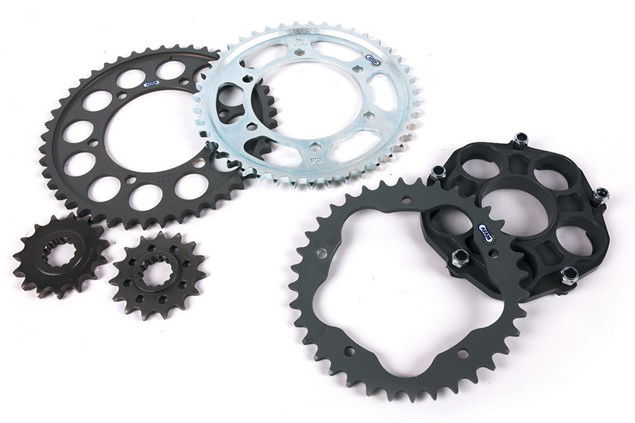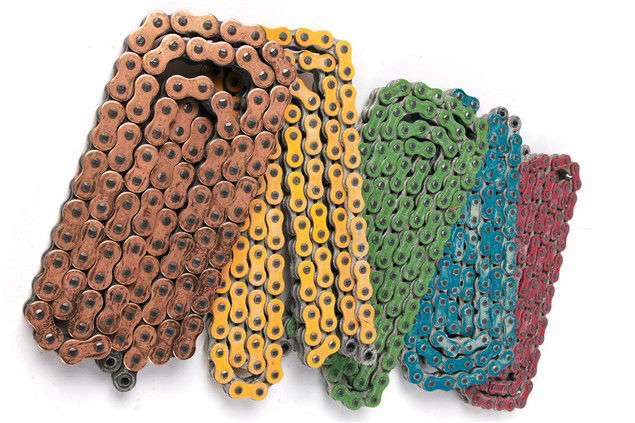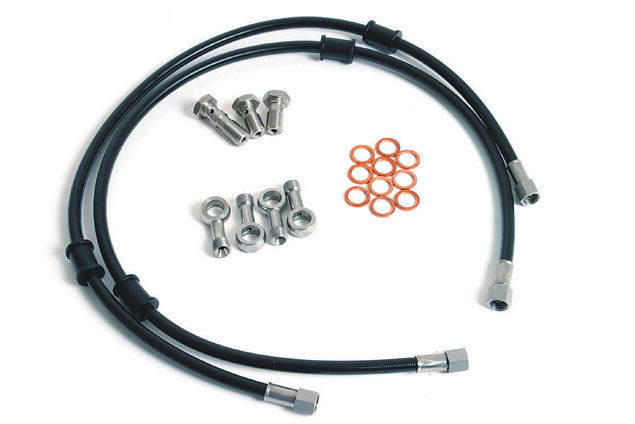Understanding Gearing
Indeed it isn't, but it sure as hell can baffle the hell out of us. Here is all you ever needed to know about the mathematical world of gearing


Like a great many things on your motorcycle (unless you have built your own gearbox entirely from scratch), the overall gearing will be factory-calculated. This will usually offer the best compromise between easy getaways in the lower ratios, optimum acceleration through the 'box and as high a top speed as possible, given the major limiting factor of the engine's torque.
But if you're after changing the riding characteristics of a bike, changing the gearing is a (reasonably) straightforward place to start.
Cast your mind back to pushbikes and Derailleur gears: if you were privileged enough to have two cogs at the front, five at the back and a chain linking any combination of those sprockets together - you had gear ratios.
If you went big cog at the front and small at the back it was a bitch to make any headway from standstill, but rockin' quick when you got going, yeah? Small cog front, big cog back was good for wheelies, and all the stuff in between was for finding a compromise between how hard/fast you wanted to pedal according to the speed you wanted to make.
And all of that was in turn dependent on how much torque (turning force) your spindly little legs could make. So far so simple.
Let's explain a few things...
GEAR RATIO is the ratio between the number of turns the gearbox sprocket makes to each single turn of the rear wheel and is calculated by: driven gear divided by the drive gear. Example: 40 tooth rear sprocket divided by 16-tooth gearbox sprocket = 2.5. So 2.5:1 is the ratio of turns the gearbox sprocket has to make to turn the rear wheel one revolution.
SHORT gearing, or SHORTENING the gearing (sometimes called LOWERING the gearing) - fitting a smaller gearbox sprocket, or a bigger rear sprocket to drop the final drive ratio. Example: 40 tooth rear sprocket divided by 15-tooth gearbox sprocket = 2.66. So ratio is 2.66:1. Lowering the gearing means increasing the ratio. This lowers the speed the bike will achieve in each gear.
TALL gearing, or RAISING the gearing (sometimes called LENGTHENING the gearing) - fitting a bigger gearbox sprocket, or a smaller rear sprocket to raise the final drive ratio. Example: 40-tooth rear sprocket divided by 17-tooth gearbox sprocket = 2.35. So the ratio is 2.35:1. Raising the gearing means lowering the ratio. This raises the speed the bike will achieve in each gear.
SPROCKET CARRIER - the part the rear sprocket bolts onto, that slots into the rear wheel axle assembly.
CUSH DRIVE - the rubber inserts in the rear wheel/or sprocket carrier that limit transmission shock at take-off and at every gearchange. NB: some supermotard machines converted form motocrossers do not have a cush drive (motocross dirt acts as a cushion) and can therefore be very hard on transmissions, especially if ridden by monkeys.
PRIMARY DRIVE - the pair of gears (chain in ye olden days) that transfer torque from crankshaft to gearbox input shaft.
CLOSE-RATIO GEARBOX - a gear cluster that has ratios very closely stacked together to provide better acceleration through the gears and minimise loss of engine revs between gearchanges.
SOFT LINK - the link that joins two ends of a chain together - so-called because the pin ends can be peened over using a special tool.
GUIDE TO CHAINS
Tsubaku Sigma R
Heavy duty x-ring and o-ring gold chains with extra links to accept bigger sprockets.
Regina
High performance, long lasting x-ring and o-ring gold chains available in different sizes.
RK
Selection of o-ring and xw-ring performance chains, also available in neon red, green and blue.
Izumi
Selection of lightweight, heavy duty silver and gold o-ring off-road and competition chains.
DID
Professional VM series premium x-ring gold chains and V series o-ring gold chains.
Afam
Huge range of performance chains in gold, silver and coloured.
Gearing Do's, on the road and track

Do's & Don't's
DO check the chain run when you've changed gearing. If you go too big at the front the chain can foul the cases, swingarm, chainguard, and anything in its way. A chain is made (unsurprisingly) from very hard metal and it doesn't mess about when it comes to eating through expensive bits of motorcycle. If you go too big at the back the same applies, with risk of the chain munching its way through bits of frame - not so good.
DO think about where you add or subtract sprocket teeth. A 14T front sprocket is the absolute minimum a chain can wrap itself around without severe wear. Of course it's easier to change a front than a rear sprocket, but always check the chain run - a 50T rear sprocket and a 14T gearbox sprocket could be changed to a 44T rear and 16T front for the same overall gearing and a far better chain run. For what it's worth, industrial chain manufacturers recommend a minimum 19 teeth for a drive sprocket in commercial applications.
DO remember to order a chain with extra links corresponding to how many teeth you add to a rear sprocket when you change it.
DON'T even think about fitting a soft-link without the correct tools (not a hammer and drift) which means most chain jobs are now dealer affairs.
DON'T gear your bike up from standard unless you want a snatchy bike in town and a slow bike on the road. Unless you're converting a motocrosser or enduro bike into a Supermotard.
On the road
On a motorcycle the usual six gears are tucked away in the crankcases (unless things go bad). We'll leave them for now and concentrate on the gearbox sprocket, chain, and drive sprocket - collectively known as the final drive (ie:the transmission system that transmits torque from gearbox to rear wheel).
Say you own an Aprilia RSV, a bike that tops out around 170mph on stock gearing (17-tooth gearbox (or front) sprocket, 42-tooth rear sprocket). Unless you live very close to an unrestricted German autobahn or the Cronk-y-Voddy straight on the Isle Of Man, you have little real need of those 170 mphs (however impressive they sound on paper). Be realistic: when was the last time you maxed-out your superbike - apart from in your dreams?
And even if all your track days took place at Mugello or Barcelona (tracks with the fastest straights in MotoGP) you might run faster laps with 'shorter' gearing. Unless you're chasing maximum top speed, most road bikes are over-geared, even on big, long tracks.
Shortening gearing on nearly all bikes results in better acceleration. This is because manufacturers are generally forced to gear bikes high to pass drive-by noise regulations and if they gear them too short, there could be liability 'issues' with fools looping things...
So, assuming you want to gear your RSV down, first establish how much you want to gear it down; like this: bike does 170mph flat in top on a 17T front/42T rear gearing, so what effect would a 16T gearbox sprocket have?
Divide 16 by 17 to get 0.94, then multiply 170mph by 0.94 to get 160mph - your new top speed. Or if you prefer working on the rear sprocket (where an increase in teeth will reduce top speed): go up from 42 to 45, so divide 42 by 45 to get 0.93, multiply 170 by 0.93 and arrive at 158mph. Different means of achieving similar results, the law being that one tooth off the front is roughly equal to adding three teeth at the back.
On the track
Racebikes without easily changeable internal ratios or full-on cassette boxes are generally geared to rev-out (or be a couple of revs off the limiter) at the fastest part of the track, usually at the end of the longest straight just before the braking area.
But if you're using that system and there's a gear that's wrong for a crucial turn (either too low so the engine revs out, or too high so the engine's short of drive) then a bit of top speed can be sacrificed to get one crucial turn right. Especially if it's one that leads onto the start/finish straight.
Before Grand Prix machines were limited to six-speeds, many of the smaller machines had ten or more gears making it easier to get off the line well and achieve a high maximum speed. But for six-speed 125s and 250s, getting off the line requires a bit of paddling and a gentle touch on the clutch lever.
GUIDE TO SPROCKETS
Renthal
Stainless, hard anodised and alloy front and rear sprockets, various colours.
B&C Express, 01522 791369 www.bandcexpress.co.uk
Regina
Competition and road-use sprockets available in different materials and sizes.
PBR
Aluminium and stainless steel CNC machined sprockets also available as kit with RK chain.
JT
Front and rear sprockets manufactured to high specification from hardened steel, various sizes available.
DID
Lightweight aluminium and stainless steel competition and road sprockets in varying sizes.
Afam
Light weight aluminium rear and lightened steel front race sprockets.
Sponsored By

Britain's No.1 Specialist Tools and Machinery Superstores
When it comes to buying tools and machinery, you need to know you're buying from specialists who know what they're talking about.
Machine Mart eat, sleep and breathe tools and machinery, and are constantly updating their range to give you the very best choice and value for money - all backed by expert advice from their friendly and knowledgeable staff. With superstores nationwide, a dedicated mail order department and a 24 hour website offering quality branded items at fiercely competitive prices, they should be your first choice for quality tools and equipment.

